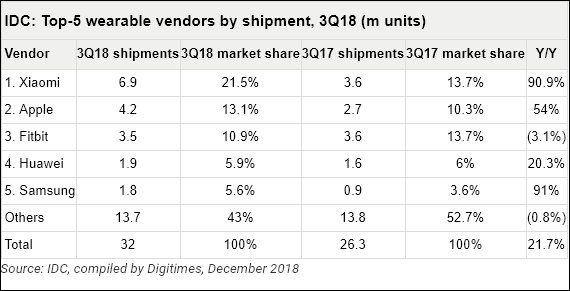Latest data released by IDC indicates that the global shipments of wearable devices reached 32 million units in the third quarter of 2018, up 21.7% from the previous year. The data shows that the astronomical rise in shipments YoY is due to a sporadic increase in the number of new wearable devices OEMs introduced during the quarter. Specifically, new products from the likes of Fitbit, Garmin, and Huawei were shown to have helped the basic wearables category return to growth during the quarter.
The data also showed that growing demand in markets like Asia-Pacific (excluding Japan) was another driving factor and this accounted for more than half of all shipments. The growth in these markets was up to 21.4% higher than the previous year, according to IDC. The US market transitioning from one driven by new users to one that relies on replacement devices and upgrades and so, the market declines 0.4% Year on Year.
In the third quarter under review, Xiaomi grabbed the top position, thanks to the success of the Mi Band 3 and its significant expansion beyond its home country of China. Though typically China accounts for well over 80% of Xiaomi’s shipment volume, this quarter that share fell to 61% as the company managed to grow its presence in other markets such as India, Europe, and Middle East and Africa.
Closely following, is Apple which managed to launch its Series 4 Watch, its first watch approved for medical use, towards the end of the quarter. The new design and sizes along with the latest version of Watch OS were welcome changes although the latest series only accounted for less than 20% of all Apple Watch shipments. The reduced price on the still affable Series 3 accounted for the majority of Apple’s shipments during the quarter.
On the third spot is Fitbit whose latest devices, including the Versa, Charge 3, and the Ace, helped the company slow its decline compared to previous quarters. The success of the Versa catapulted the company back into reckoning as the second largest smartwatch vendor. IDC expects this to continue in the near term. Furthermore, Huawei edged Samsung to maintain its number four position worldwide but the majority of the firm’s wearable devices were sold in China. On the other hand, the Honor sub-brand introduced a new set of earphones that tracks heart rate during workouts.
Read Also: Supply chain analysis reveals how Samsung managed to make a foldable smartphone
The fifth spot is occupied by Samsung which stretched its lead past other contenders. Samsung’s product arsenal isn’t too broad and it relies on the Gear S3 and Fear Fit wristbands to drive sales volumes. The company also launched its next-generation smartwatch, the Galaxy Watch, marking the first time that a wearable device moved away from its traditional “Gear” moniker to the “Galaxy” sub-brand, alongside its smartphones and tablets.
(source)







